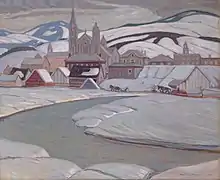Albert H. Robinson
Albert Henry Robinson, also known as Albert H. Robinson and as A. H. Robinson RCA (January 2, 1881 – September 7, 1956) was a Canadian landscape painter, an invited contributor to the first Group of Seven exhibition in 1920,[1] as well as a founding member of the Beaver Hall Group in 1920 and the Canadian Group of Painters in 1933. He used the rolling rhythm of landscape parallel to the picture plane used by A.Y. Jackson, with whom he often painted on trips to Quebec, but endowed his work with unusual colours – corals, pinks, dark blue.[2] He sought simplified, powerful form[2]
Albert H. Robinson | |
|---|---|
| Born | Albert Henry Robinson January 2, 1881 |
| Died | September 7, 1956 (aged 75) Montreal, Quebec |
| Nationality | Canadian |
| Education | Hamilton Art School with John S. Gordon; Académie Julian with William-Adolphe Bouguereau and École des Beaux Arts with Gabriel Ferrier, Paris (1903) and also with the American Thomas William Marshall (painter) in Normandy and Corsica (1903–1905) |
| Known for | landscape painter; teacher, Hamilton Art School, starting in 1905 |
| Movement | Impressionism |
| Spouse(s) | Marion Ethelwynne Russell, married 1952 |
| Awards | Member in 1920, Royal Canadian Academy |
| Elected | founding member, Beaver Hall Group, Montreal in 1920, and of the Canadian Group of Painters, 1933; Pen and Pencil Club, Montreal, 1911 |
Career

Born in Hamilton, Ontario, Albert Henry Robinson's first studies were with John S. Gordon at the Hamilton Art School. In 1903-04, he was in Paris, studying first at the Académie Julian under Bouguereau and Bashet then at the École des Beaux-Arts under Gabriel Ferrier, and also with artist, Thomas William Marshall. About 1908 he began to paint the Quebec landscape and moved to Montreal. In 1910 he met A.Y. Jackson and went with him the next year to France, visiting St. Malo and Carhaix in Brittany. In 1911 he was elected an associate of the Royal Canadian Academy and that year was in Europe again, and in 1920 became an academician.
His career included serving in the war industry as inspector of munitions during World War I (1917–1919). He was commissioned by the Canadian War Memorials to paint the Vickers Shipbuilding plant in Montreal.[2]
From about 1918 to 1933, Robinson painted on trips along the St. Lawrence River and in the Laurentians with Jackson, Clarence Gagnon, Edwin Holgate and Randolph Hewton.[2] In 1921, he painted with Jackson at Cacouna where he made studies for Returning from Easter Mass. He retired due to a heart attack which when he recovered, was followed by arthritis.[3][2]
His dealer was William R. Watson of Watson Art Galleries, then Walter Klinkhoff Gallery, Montreal and today, Alan Klinkhoff Gallery in Montreal and Toronto and Eric Klinkhoff Gallery in Montreal.[2] In 1982, Jennifer Watson for the Kitchener-Waterloo Art Gallery curated a retrospective exhibition which travelled to seven other galleries, Albert H. Robinson: The Mature Years; in 1994, Walter Klinkhoff Gallery organized a retrospective with a catalogue.
His work is in the National Gallery of Canada, Ottawa; the Art Gallery of Ontario, Toronto; the Art Gallery of Hamilton; McMichael Canadian Art Collection, Kleinburg; Montreal Museum of Fine Arts and the Musée National d'Art Moderne, Paris, among others.[2]
References
- Watson 1982, p. 19.
- MacDonald 1990, p. 2203-2207.
- Robinson, Albert H. "Overview". www.klinkhoff.ca. Alan Klinkhoff Gallery. Retrieved August 12, 2020.
Bibliography
- The Art Gallery of Hamilton, the National Gallery of Canada (1955). Albert H. Robinson: Retrospective Exhibition.
- Prakash, A.K. (2015). Impressionism in Canada: A Journey of Rediscovery. Stuttgart: Arnoldsche Art Publishers. ISBN 978-3-89790-427-9.
- MacDonald, Colin (1990). A Dictionary of Canadian Artists, vol.7 (First ed.). Canadian Paperbacks Publishing Ltd. ISBN 0-919554-13-X. Retrieved August 11, 2020.
- Watson, Jennifer (1982). Albert H. Robinson: The Mature Years. Kitchener: Kitchener-Waterloo Art Gallery. Retrieved August 11, 2020.